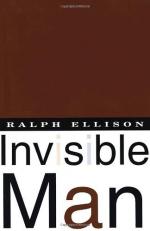|
This section contains 1,727 words (approx. 5 pages at 400 words per page) |

|
Johnson teaches American literature at the University of Pennsylvania where he recently received his Ph.D. In the following essay, he discusses the parallels and differences between the Emersonian reflection of the ideal self and Ellison's "Battle Royal."
In 1846, Ralph Waldo Emerson's essay "Nature" elucidated the optimistic promise of American individualism. Emerson describes how the wilderness— "these plantations of God"—liberate the human spirit. He writes, "Standing on the bare ground— my head bathed by the blithe air and uplifted into infinite space; all mean egotism vanishes; I become a transparent eyeball; I am nothing; I see all; the currents of the Universal Being circulate through me; I am part or parcel of God." Emerson's reflection on the ideal self or "I" sets up contradictions that echo in Ralph Waldo Ellison's story "The Invisible Man." Throughout his ordeal, the narrator adopts an Emersonian optimism that enables him to...
|
This section contains 1,727 words (approx. 5 pages at 400 words per page) |

|




